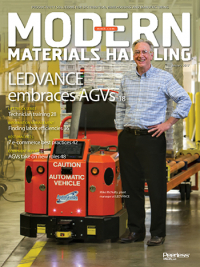Lift Truck Tips: Changing the current of lift truck maintenance
Electric equipment offers more data, which is only as good as the practices to apply it.
Beginning about 10 years or so ago, lift truck manufacturers started replacing DC motors and controllers with AC motors in electric lift trucks. The benefits of brushless motors and regenerative braking reduced maintenance costs by as much as $350 in parts alone each year and cut 45 minutes from the previous two-hour length of a planned maintenance (PM) event. An added benefit is the ability of AC motors to provide more access to data about the equipment’s condition, a capability that has become increasingly important as fleet maintenance solutions become more detail-oriented.
“AC technology gives more places to tap into the forklift and get data, like the hours of operation, the location of the truck, time spent lifting or using hydraulics, and battery life,” says Wayne Wilde, senior manager of special projects for UniCarriers Americas. “DC motors often took a lot of time to diagnose, but with an AC truck, you can see amp draw, the temperatures of motors and controllers, max voltage and more.”
As with any new source of data, one of the biggest challenges is how to transmit and deliver it to the end-user in the best mode, Wilde says. Some of UniCarriers’ top customers are collecting data in different systems without a common, unifying platform.
“The industry is now looking into a standard configuration,” he says. “Almost all manufacturers are looking at the next generation of meters and controllers to transmit and download either to an iPhone or to a central database so you can look at overall performance of the truck from any location and dispatch accordingly.”
The goal of these more detailed and disciplined maintenance practices is to reduce costs, but Wilde says each company will approach it from a different angle. The size of the fleet will determine where or how fast they make a change, he says. Smaller fleets often wait until a lift truck is just too expensive to maintain, and they often don’t learn that until a couple years after they’ve been spending too much.
“Fleets above 15 units are paying attention to the cost per operating hour and are trying to get a handle on downtime,” he adds. “I have customers come to me and ask which is more important, the cost per hour or downtime? Is your business predicated on production and uptime? Is it seasonal, and starting in October it is critical to not have a breakdown? How many rentals have you used because of breakdowns? And, what do you do when the accountant says maintenance costs are up 25%?”
Smaller companies have to determine if productivity and uptime or the cost per hour is their main goal, Wilde stresses. “Once they determine that, they can start to attack the problem,” Wilde says. “Maybe opportunity charging is the way to go, since your battery maintenance practices are terrible. It will be different for everyone.”

Article Topics
Lift Truck Tips News & Resources
Overlooked no more: The importance of lift truck inspections Lithium transition: It’s all about the outcomes Safety for automatic guided vehicle (AGV) environments Assessing the move to lithium Leasing’s fleet management upside Managing for lift truck operator safety Narrow aisle success: Think systems, then trucks More Lift Truck TipsLatest in Materials Handling
Hyster recognizes Dealers of Distinction for 2023 Carolina Handling names Joe Perkins as COO C-suite Interview with Keith Moore, CEO, AutoScheduler.AI: MODEX was a meeting place for innovation Walmart deploying autonomous lift trucks at four of its high-tech DCs Coles shops big for automation Kathleen Phelps to join FORTNA as chief financial officer Coles automates grocery distribution in Australia More Materials HandlingAbout the Author
Subscribe to Materials Handling Magazine

Find out what the world's most innovative companies are doing to improve productivity in their plants and distribution centers.
Start your FREE subscription today.
April 2024 Modern Materials Handling

Latest Resources












